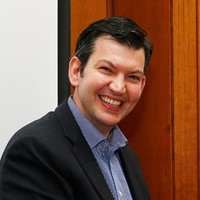Face to Face: Mr Rick Heikoop
 Rick Heikoop – Senior lecturer Water Management at Rotterdam University of Applied Sciences.
Rick Heikoop – Senior lecturer Water Management at Rotterdam University of Applied Sciences.
Rick has a 15+ years record of achievement and demonstrated success in initiating, managing and leading (international) collaborations and partnerships in the water sector in triple helix setup. He is senior lecturer Water Management at Rotterdam University of Applied Sciences (RUAS) and project manager at RDM Centre of Expertise.
He was involved in the development of the courses Water Management and Real Estate Management at RUAS. He co-initiated Wetskills.com in 2010, which organized up to date 31 water challenges in 19 different countries with 617 international young professionals. He is currently managing different international projects such as the DUTEP project in which more than 30 officers from the Jakarta city government participated since 2014 in a ten weeks exposure programme in Rotterdam to learn and experience Dutch Urban Water Management. And several Erasmus Plus projects in collaboration with partners in Indonesia and the Philippines.
Rick is passionate about International collaboration and setting up new projects and initiatives to make better cities. ‘It’s fun to visit other places and work together with people from other countries to work on today’s challenges and make better cities, cleaner rivers and improve water management’. Rick is currently working on two of his passions: the Sani-embankment Philippines, which integrates a helophyte filter system in a river embankment, to provide sanitation facilities along river banks in Davao City and City scan method which aims to gather in a short period of time (1-2 weeks) essential data by young professionals and practitioners that enable them to assess the ‘level of resilience’ of a specific street, neighborhood or city with low-cost and low-tech tools and instruments with the aim to create awareness and formulate concrete actions to make resilient cities which were organized in Manila, Cebu City and Rotterdam. This approach was presented at conferences and South Africa and Singapore. Rick is actively involved as the programme manager in Wetskills for which he organized Wetskills challenges since 2010 in China, Egypt, Indonesia, Morocco, South Africa, Netherlands, Philippines, and other countries. He organized in collaboration with a Swiss partner and 150 Swiss students to Sketch city events in Rotterdam.
Could you tell us about your professional background and how it led you to work in Climate Change and urban resilience?
The Netherlands is a low-lying country, located in the Rhine–Meuse–Scheldt delta. The Netherlands is an example of a country highly susceptible to both sea-level rise and river flooding because 55% of its territory is prone to flooding. 26% per cent of the country is below sea level and 29% is prone to riverine flooding by the river systems of Meuse, Rhine and Scheldt. The Netherlands has a long history of living with water. The first waterboards were established around 1200. The Rotterdam region, where I work and live, is located in the lowest part of the Netherlands. A few kilometers away from Rotterdam is The Zuidplaspolder. It reaches a depth of 6.76 meters (22.2 ft) below average sea level. This makes it one of the lowest point of Western Europe and the European Union. Water management is a necessity in the Netherlands to survive. Pumping stations pump the water from the lowest level to the higher levels. Originally pumping was done by windmills, then by steam engines and now with electrical pumping stations.
I studied Land and Water Management in the Netherlands, then I did a Master’s study Urban and Regional Planning at University of the Philippines in Cebu City. Fascinated by the urban challenges of today, I finished a Master’s degree Urban Management of The European Metropolitan Region at Erasmus University Rotterdam. Because of climate change delta cities around the world are becoming more and more vulnerable for climate change. In the Netherlands we are very much aware of that, since we are already partly below sea level. Flooding takes place of large urban metropolitan cities around the world, like Manila, Jakarta, Bangkok, but also cities at New York, Houston, Melbourne and many more cities around the world. Because of groundwater extraction many cities are sinking cities, while at the same time sea water level rises. At the same time these cities also have the deal with drought and longer periods of heat as we experienced this summer in Europe. It is a big challenge to prepare our cities around the world for the effects of climate change, and how to adapt and make our cities resilient.
Could you share about current research or project you are working on?
I am working on the development of the City Scan methodology. Cities and local governments cannot adapt alone. They are depending on the efforts of communities and citizens to take measures at the household level and street level. Cities formulate ambitions and visions at the city level, but this is often not translated to the neighborhood level. We can tick if a certain project is implemented, but we don’t know when a city or street is ‘climate proof’, so to say.
In Rotterdam citizens and business are urged to take adaptive measures, like creating green roofs and to take out concrete from private gardens to increase infiltration capacity. But city governments don’t have specific data to track progress on street level that enable us to say if a certain street is ‘climate proof’. It would be great if we could collect data at street level about a range of variables at street level, like a shadow, temperature, infiltration capacity, water quality, plastic waste, etc. At the building level, we could also identify a range of variables. With these variables, we can compare streets and cities and we know what measures could or should be taken to become more resilient.
Could you explain why Climate Change and Resilience is important to architects and urban planners to understand and apply in their own field?
Urban Resilience is defined by the 100 resilient cities as “the capacity of individuals, communities, institutions, businesses, and systems within a city to survive, adapt, and grow no matter what kinds of chronic stresses and acute shocks they experience.” We should look at a city holistically, and understand the city system. If we have a better understanding of the potential shocks that our cities might face, we can improve the development trajectory of our cities, and improve the wellbeing of its






